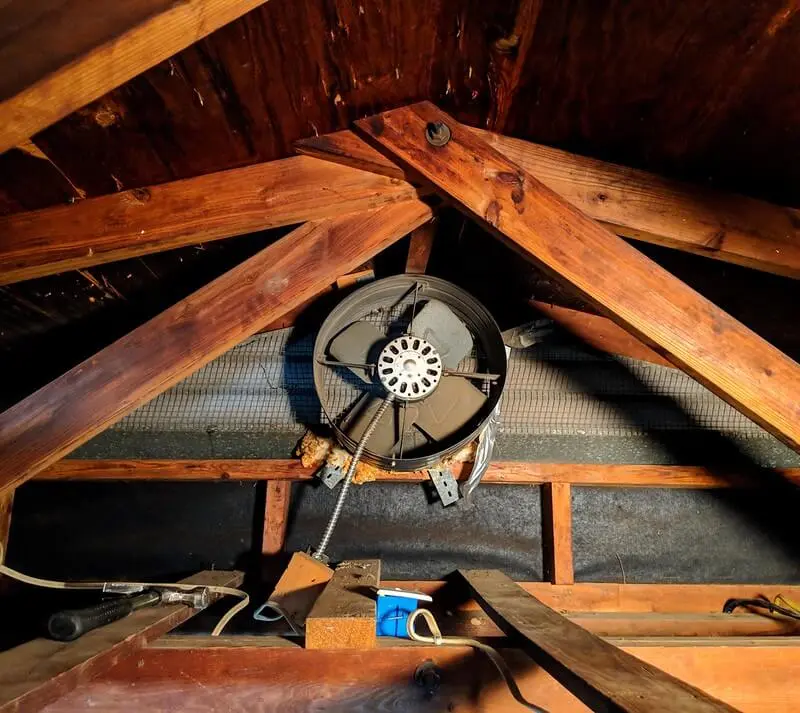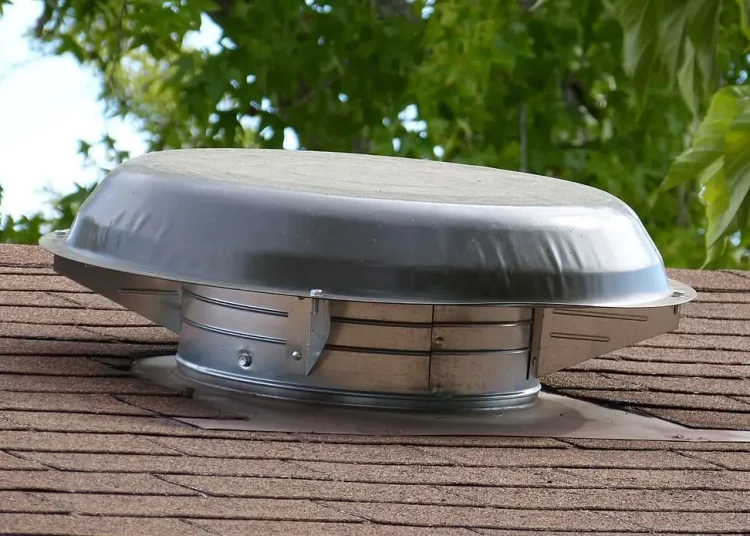Properly maintaining your attic space is essential for keeping your home in optimal condition.
Ventilation plays a key role – fresh air coming in and hot attic air being released help regulate the temperature and stop moisture buildup.
Attic fans can be a great asset, as they bring in new air from the outside and remove the air inside. This ensures that your attic stays healthy, safe, and pleasant.
Do I need an Attic Fan?
You may not need an attic fan if your attic is finished with enough passive ventilation. However, if the inside temperature is more than 20 degrees hotter or colder than the outside temperature, or there are signs of mold issues, it may be time to consider getting a fan.
An attic fan can help circulate fresh air and prevent extreme temperatures from entering your home. Make sure to purchase one certified for safety and suitable for your climate.
When shopping for an attic fan, there are a few important things to consider:
- Location: Attic fans can be installed through the roof or an exterior wall. Roof-mount fans are one option while gable-mount is reserved for those that penetrate an exterior wall.
- Power source: Which option best suits your needs – electric lines, batteries, or solar power?
- Proper sizing: Ensure the fan you choose isn’t too large! An oversized fan may suck air from gaps in the ceiling and cause heating/cooling issues in your attic. Look for a fan with a CFM figure that’s 70-80% of your attic’s square footage – IRC section R806 has more information.
- Ease of installation: Installing an attic fan can be done as a DIY project should electrical lines already exist in the area.
- Durability: An attic fan must withstand extreme weather conditions and animal invasions.
- Cost: Don’t forget to compare prices before making your final selection – this will help you save on costs.
- Convenience: Will you need to access the attic each time you run the fan? Or will it be controlled by a thermostat?
Types of Attic Fans
Most people don’t think about attic fans until there’s a problem with their home’s ventilation. But having the right type of attic fan can make all the difference in your home’s air quality and comfort.
There are two types of attic fans: the roof-mounted attic fan and the gable-mounted attic fan.
Roof Mounted Attic Fans

A roof-mounted attic fan is a type of fan that can be powered by electricity or solar energy. It’s installed directly on your roof and works by drawing out hot air from your attic, lowering temperatures in your home.
An advantage to this type of fan is that it’s easy to install and doesn’t take up any extra space inside the house. It also looks nice since it blends in better with the roofline than other types of fans.
However, because it’s installed on a slanted surface, you may need special mounting hardware or hire someone experienced to put it in correctly.
Gable Mounted Attic Fans

Gable-mounted attic fans are installed in an air vent hole inside the gable wall (the triangle formed between two sides of a pitched roof). Like roof-mounted fans, they draw hot air out of your attic and help save energy costs during hotter months.
They are also easy to install but can be harder to get to if repairs need to be done later.
Plus, if you live in an area with severe weather like hurricanes or tornadoes, gable fans might not be the best choice because strong winds can cause them to come off their mount more easily than roof-mounted ones.
You might be interested: The Thrill of Building Your Own Home – Zero Experience Required
The Importance of Temperature Control in Attic Ventilation
Keeping your attic properly ventilated and at the right temperature is important for the overall health of your home. To properly ventilate an attic, it’s important to understand how temperatures play a role. Let’s take a closer look at how temperatures play in attic ventilation.
Understanding Attic Temperatures and Temperature Differentials
The right temperature for a typical attic can vary depending on the outside weather. Usually, experts say it’s best to keep the attic temperature between 77-95 degrees Fahrenheit (25-35 degrees Celsius).
It’s important to think about the temperature difference too. That’s the difference between inside and outside temperatures. This will make the attic comfy and stop hot or cold air from getting inside.
The bigger the difference, the more air will flow in and out of the attic, which helps prevent too much moisture. If you live in a place with very hot or cold weather, you might need to adjust the recommended temperature.
For example, if it’s always hot where you live, you might need to lower the ideal temperature, so it’s not too hot in the attic.
Knowing the right temperature for your attic can make your living space more comfortable and protect your stuff from harm caused by heat or too much moisture.
The Benefits of Attic Fans
Many homeowners are unaware of the potential benefits that attic fans can offer. Installing an attic fan in your home can help to improve air movement, reduce heat transfer and insulation degradation, and maintain an optimal year-round climate in the attic.
Let’s take a closer look at some of these advantages.
Optimal Year-Round Attic Climate
An attic fan helps maintain the optimal year-round climate in your home by expelling hot air from your attic space. This helps control the temperature in your attic so that it’s not too hot or too cold, which can cause damage to the insulation or other materials stored in the area.
The fan also helps reduce humidity levels and prevent moisture buildup in the space, which can lead to the growth of mold and other issues.
Improved Air Quality in the Entire House
An attic fan can help improve indoor air quality by drawing out stale and stagnant air and reducing airborne allergens like dust, pollen, and other micro-particles.
This can potentially reduce allergies or asthma symptoms, providing a healthier living environment for you and your family. Additionally, an attic fan can help regulate temperatures in your home more efficiently, leading to cost savings on energy bills.
Reduced Heat Transfer and Insulation Degradation
Attic fans are useful for reducing heat transfer between the different parts of your house. It helps maintain a stable temperature, especially in kitchens and bathrooms. They’ll also stop a lot of heat from building up so other rooms don’t get too hot.
Attic fans also help with airflow and reduce moisture, keeping insulation in good shape. This means you could use less energy and save money on cooling costs in summer – plus, they can work with humidifiers to circulate warm air in winter.
Cons of Using an Attic Fan
Attic fans seem like a great solution for beating the heat and saving on energy costs. But before you install one, there are some important things you need to know. Here are four cons of using an attic fan that you should be aware of:
Energy Bills Can Go Up
Using an attic fan may actually increase energy consumption. The fan needs electricity to run, so it’s using up energy. And if you need to run it for long periods, your energy bill could soar.
Plus, if the fan draws hot air into your attic from outside, your air conditioning system will have to work extra hard to keep your house cool, making your energy bills even higher.
Leaks Can Happen
If your attic fan isn’t installed correctly, it can cause leaks. These leaks can lead to water damage to your home and mold growth, which can make you and your family sick. To avoid this, make sure a professional installs your fan.
Carbon Monoxide Danger
Your attic fan could be putting you at risk for carbon monoxide exposure. If the fan draws fumes from appliances, like your stove or water heater, into your attic and home, it could be dangerous for your health.
Make sure a pro installs your fan and inspects it regularly to prevent carbon monoxide exposure.
Moisture Issues
The fan pulls hot air out of your attic, but it has to be replaced by air from outside. This air can be hot and humid, increasing moisture in your attic and home. This extra moisture can cause mold growth and damage to your roof structure and home.
To avoid this, make sure your ventilation system is balanced and provides enough fresh air to your attic and home.
You might be interested: Everything You Need To Know About Barndominiums
Frequently Asked Questions About Attic Fan
What is the difference between an attic fan and an exhaust fan?
Attic and exhaust fans are similar in their purpose of pushing air out of space, but they differ in their installation locations. An attic fan is typically installed near the roof, while an exhaust fan is usually located near the floor or closer to living areas.
Attic fans are usually used as a cooling method, while exhaust fans are used to remove moisture and pollutants from the air.
Is it expensive to run an attic fan?
An attic fan unlike house fans doesn’t have to be expensive to run. Solar attic fans use around 30 watts of electricity, so running them is much cheaper than using traditional electric attic fans since they use solar panels.
How much does a solar attic fan reduce temperature?
Solar attic fans can reduce the hot temperature in an attic by as much as 30-40 degrees F, depending on current conditions like size and attic insulation levels. In addition to cooling the attic, a solar attic fan helps reduce moisture buildup within the space, further increasing the cooling effect.
How long do attic fans last?
Attic exhaust fans typically last an average of 15 years with proper maintenance and care. To maintain the fan, it is important to clean the blades, check the heat sink fins and DC Motor, and check for blockages regularly. Additionally, depending on the type of fan, you may need to replace parts after some time.
Do attic fans cool your house?
Attic fans can help to reduce the temperature in your home by up to 5 degrees, leading to a cooler atmosphere within your attic. This makes for a more comfortable room and also helps extend the life of your air conditioning system since it will have to work less to cool the space.
How many attic fans do I need?
You should install one attic fan for every 300 square feet of the attic if the attic has a vapor barrier. Without this covering, you would need one for every 150 square feet instead. Additionally, any attic up to 150 square feet in size should have 1 sq ft of ventilation. Properly sizing and installing fans can help to ensure they last as long as possible.
Can I install an attic fan myself?
It is possible to install an attic fan yourself. To do so, start by using an existing roof or gable vent for the installation. This will help to save time and avoid making a new hole in the roof. Once the existing vent has been adapted to fit the fan, you can easily have the attic fan up and running in no time.
Can you run the attic fan with the windows closed?
Operating an attic fan with all windows closed will not be effective, as it restricts the air extracted from your home. The fan requires a steady flow of air to work properly, which cannot happen if the windows are closed.
To maximize the efficiency of your attic fan, ensure windows are open while running and clean the blades regularly to avoid any blockages due to dirt or dust.
How big of an attic fan do I need?
The size of the attic fan you need depends on the climate in which your home is located. Generally, it is recommended to size the fan at 2 to 3 CFM (cubic feet of air per minute) per square foot of living space.
For coastal or mountain climates, it is typically recommended to use 2 CFM per square foot. Additionally, make sure the fan you choose is certified and meets the required safety standards.
Where is the best location for an attic fan?
The best location for an attic fan is an unobstructed hallway in the center of your attic that has enough space to allow the fan shutters to open and close without obstruction.
Ensure there are not too many pipes or wires nearby, as this could interfere with the fan’s performance. Additionally, keep the area clear of dust and dirt for optimal functioning.
Conclusion
Installing an attic fan is a smart choice for many reasons. It helps to remove extra heat and moisture from the attic to protect the structure. You’ll also save money on energy bills because you won’t need as much air conditioning.
Plus, it can prevent ice dams in winter and make your home healthier by removing allergens and dust particles. An attic fan will give you long-term benefits, including saving energy, better air quality, and ensuring the underlying structure lasts longer.




















